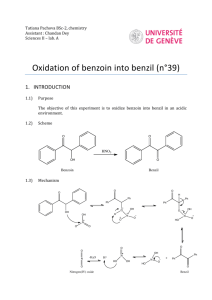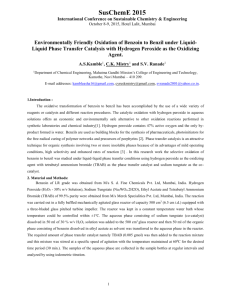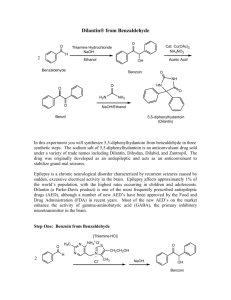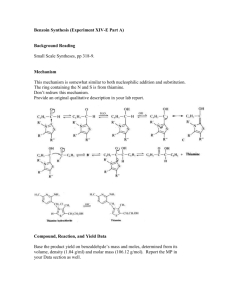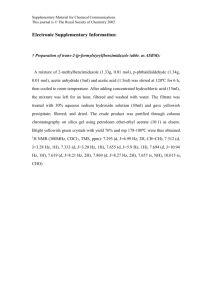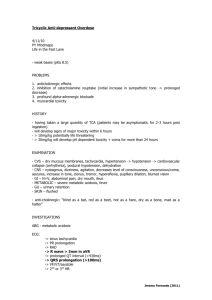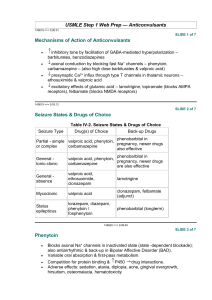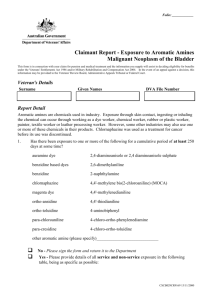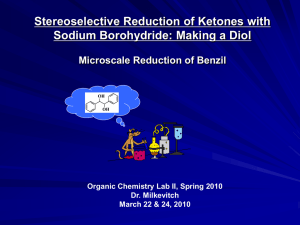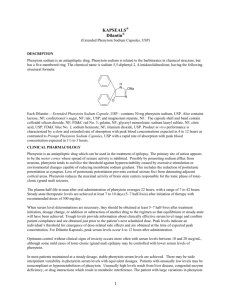(Phenytoin) from Almond
advertisement
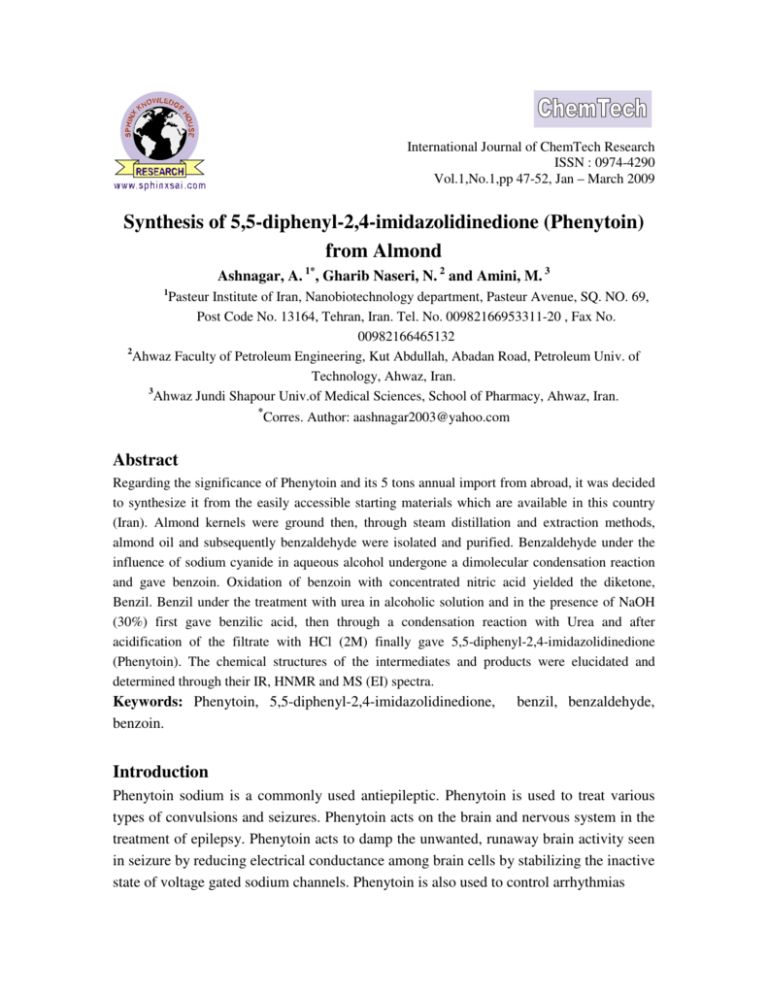
International Journal of ChemTech Research
ISSN : 0974-4290
Vol.1,No.1,pp 47-52, Jan – March 2009
Synthesis of 5,5-diphenyl-2,4-imidazolidinedione (Phenytoin)
from Almond
Ashnagar, A. 1*, Gharib Naseri, N. 2 and Amini, M. 3
1
Pasteur Institute of Iran, Nanobiotechnology department, Pasteur Avenue, SQ. NO. 69,
Post Code No. 13164, Tehran, Iran. Tel. No. 00982166953311-20 , Fax No.
00982166465132
2
Ahwaz Faculty of Petroleum Engineering, Kut Abdullah, Abadan Road, Petroleum Univ. of
Technology, Ahwaz, Iran.
3
Ahwaz Jundi Shapour Univ.of Medical Sciences, School of Pharmacy, Ahwaz, Iran.
*
Corres. Author: aashnagar2003@yahoo.com
Abstract
Regarding the significance of Phenytoin and its 5 tons annual import from abroad, it was decided
to synthesize it from the easily accessible starting materials which are available in this country
(Iran). Almond kernels were ground then, through steam distillation and extraction methods,
almond oil and subsequently benzaldehyde were isolated and purified. Benzaldehyde under the
influence of sodium cyanide in aqueous alcohol undergone a dimolecular condensation reaction
and gave benzoin. Oxidation of benzoin with concentrated nitric acid yielded the diketone,
Benzil. Benzil under the treatment with urea in alcoholic solution and in the presence of NaOH
(30%) first gave benzilic acid, then through a condensation reaction with Urea and after
acidification of the filtrate with HCl (2M) finally gave 5,5-diphenyl-2,4-imidazolidinedione
(Phenytoin). The chemical structures of the intermediates and products were elucidated and
determined through their IR, HNMR and MS (EI) spectra.
Keywords: Phenytoin, 5,5-diphenyl-2,4-imidazolidinedione,
benzoin.
benzil, benzaldehyde,
Introduction
Phenytoin sodium is a commonly used antiepileptic. Phenytoin is used to treat various
types of convulsions and seizures. Phenytoin acts on the brain and nervous system in the
treatment of epilepsy. Phenytoin acts to damp the unwanted, runaway brain activity seen
in seizure by reducing electrical conductance among brain cells by stabilizing the inactive
state of voltage gated sodium channels. Phenytoin is also used to control arrhythmias
A. Ashnagar et al./Int.J. ChemTech Res.2009,1(1)
48
(irregular heartbeat) and to treat migraine headaches and facial nerve pain. Phenytoin
(diphenylhydantoin) was first synthesized by German physician Heinrich Biltz in 1908.
In 1938, outside scientists including H. Houston Merritt and Tracy Putnam discovered
phenytoin’s usefulness for controlling seizures, without the sedative effects associated
with phenobarbital. There are some indications that phenytoin has other effects, including
anxiety control and mood stabilization.1Phenytoin (VI), when in the form of its sodium
salt, can be formulated into a propylene glycol-alcohol-water solution that is used for
parenteral administration. Phenytoin is the antiepileptic of choice for most patients with
tonic-clonic status epilepticus of the grand mal type with focal and psychomotor
seizures.2The dosage should be individualized, but most adults require 100 mg three
times a day orally for satisfactory maintenance. Phenytoin also can be used to control
seizures occurring during neurosurgery when given at 100-200 mg intramuscularly at 4
hour intervals.
Experimental
Reagents: All reagents and chemicals were of analytical reagent grade and were
purchased from Merck and Pars Iran Chemical Companies. They were used without
further purification for the preparation and synthesis of the intermediates and products.
Dried bitter almonds were purchased the markets in Ahwaz, Iran.
Apparaturs: All intermediates and products were routinely examined by proton NMR
(Bruker, Germany, 300 MHz), IR (JASCO, 700 IR) and mass spectrometer (Finnigan
MAT: Q70, USA).
1.
Preparation of benzaldehyde from bitter almond: First, the kernels were
separated crushing the dried fruit, then, they were powdered by an electrical mill. The
powdered kernels were poured inside a metallic vessel and placed under a hydraulic press
and pressure was exerted until its fatty oil was extracted. The residue was crushed again
and macerated in warm water (40-60 °C) for 24 hours. During this time, glycosidic
amygdalin was hydrolyzed and the volatile oil (almond oil) was isolated. Steam
distillation of the mixture resulted in the separation of the volatile oil along with
cyanidric acid (HCN). In order to separate the acid, calcium hydroxide solution was
added to the mixture and distilled, benzaldehyde was separated, the yield was low (ca.
0.4%) and the whole process was repeated several times. The IR spectrum (neat liquid) of
benzaldehyde had ν− (cm-1): 2840, 2730 (CH, aldehyde, m-w), 1694 (C=O, s), 1597,
1583, 1454 (C=C, aromatic ring, m).
A. Ashnagar et al./Int.J. ChemTech Res.2009,1(1)
49
2.
Preparation of benzoin from benzaldehyde: In a 1000 mL round-bottomed
flask, ethanol (200 mL 95%), benzaldehyde (150 g, 142.5 mL, 1.41 mol) and a solution
of sodium cyanide (15 g) in water (150) were placed and refluxed for 3 hours. Then, the
contents of the flask were cooled in an ice bath. Benzoin was precipitated as a solid
material and collected over a Buchner funnel. It was washed several times with cold
distilled water to remove the excess sodium cyanide. A second batch of benzoin was
obtained by heating the mother liquor on a hot plate. The batches were added together
and recrystallized from 95% ethanol. Pure benzoin was obtained as a white crystalline
material (130 g, 0.511 mol, 87%). Its m.p. was found to be 128-130 °C (literature 134135°C).3 Its IR (mull in nujol) hadν− (cm-1): 3500-3100 (OH, br, s), 3050 (C=CH,
aromatic), 1680 (C=O, s), 1590, 1585, 1480 (C=C aromatic, m); its1HNMR (CDCl3 ,
300 MHz) had δ( ppm): 4.85 (s, 1×H, OH), 5.95 (s, 1×H, CH), 7.36, 7.96 (5×H
aromatic ring), 7.36-7.42 (t, 2×H); its CNMR (CDCl3 , 75 MHz) had δ( ppm): 133.4 (C1
of ring A), 138.9 (C1 of ring B), 133.8, 129.1, 128.6, 128.5, 127.7 (10×C atoms of rings
A and B), 198.9 (C=O); its MS (EI) showed m/z: 212{[M]+., 6%}, 195 {[M-OH]+, 58%},
105 {[M-PhCHOH]+, 100%}, 77 {[ M-(PhCHOH + CO)]+, 33%}.
3. Preparation of benzil from benzoin: Benzoin (50 g, 0.235 mol) was placed in a
1000 mL Erlenmeyer flask and concentrated nitric acid (250 mL) was added into it in a
fumecupboard. The mixture was heated on a hot plate with occasional shaking until all
the red coloured nitrogen oxide gas was evolved (about 2 hours). The mixture was
transferred to another 2000 mL Erlenmeyer flask which contained 1000 mL distilled
water and stirred vigorously until the oil solidified as a yellow crystalline material. It was
filtered over a Buchner funnel and washed with a liberal quantity of cold water until all
the excess HNO3 was removed. The solid material was recrystallized from 95% ethanol
which resulted yellow needle crystalline material (44 g, 0.21 mol, 89%). Its m.p. was
found to be 92°C (literature 95°C).3 Its IR (mull in nujol) hadν− (cm-1): 3050 (C=CH,
aromatic), 1680 (C=O, s), 1595, 1585, 1450 (C=C aromatic, m); its1HNMR (CDCl3 ,
300 MHz) had δ( ppm): 7.48 - 7.54 (t, 2×H aromatic ring), 7.54 - 7.58 (t, 1×H), 7.96 7.98 (t, 2×H aromatic ring); its CNMR (CDCl3 , 75 MHz) had δ( ppm): 129.8 (C3, C3’/
C2, C’), 129.8 (C2, C2’ / C3, C3’), 132.9 (C1, C1’), 134.8 (C4, C4’), 194.5 (C=O); its
MS (EI) showed m/z: 210{[M]+., 17%}, 105 {[M-PhCO]+, 100%}, 77 {[ M-(PhCHOH +
CO)]+, 16%}.
A. Ashnagar et al./Int.J. ChemTech Res.2009,1(1)
50
4. Preparation of Phenytoin: In a 1000 mL round-bottomed flask which contained 200
mL absolute ethanol and equipped with a reflux condenser, benzil (8.8 g, 0.042 mol),
urea (4.38 g, 0.073 mol) and sodium hydroxide pellets (4.7 g, 0.084 mol) were placed and
refluxed for 8 hours. Then, the mixture was poured in an ice bath which resulted in the
formation of a solid material which was filtered over a Buchner funnel. To the filtrate,
concentrated sulphuric acid was added until the pH became 5.5 – 6 and a white solid
material was obtained. It was collected over a Buchner funnel and recrystallized from
95% ethanol; a white crystalline material was obtained (6 g, 0.024 mol, 60%). Its m.p.
was found to be 288-291°C (literature 293°C).4 Its IR (mull in nujol) hadν− (cm-1): 3050
(C=CH, aromatic), 1719 (C=O, s), 1520, 1480, 1440 (C=C aromatic, m); its1HNMR
(CDCl3 , 300 MHz) had δ( ppm): 1.64 (NH), 7.26 - 7.52 (m, 10×H aromatic ring), 10.22
(s, 1×H, OH enol); its CNMR (CDCl3 , 75 MHz) had δ( ppm): 125.7 – 135.17 (12 × C
atoms of aromatic rings), 156.2 (C=O); its MS (EI) showed m/z: 242{[M]+., 17%}, 237
{[M - NH]+, 100%}, 180 {[M-(Ph)2C=N]+, 40%}, 77 {[ C6H5, 20%}.
Discussion
Regarding the significance of Phenytoin and its 5 tons annual import from abroad, it was
decided to synthesize it from the easily accessible starting materials which are available
in this country (Iran). An interesting and useful synthesis of hydantoins is the
condensation of α-diketones or α-dialdehydes with urea, followed by a pinacolone
rearrangement. In the presence of cyanide ion, benzaldehyde (I) undergoes a unique selfcondensation reaction, called the benzoin condensation, yielding an α-hydroxy ketone
called benzoin (II) (scheme 1). The formation of the hydantoin (VI) (scheme 2), involves
a molecular rearrangement in which a phenyl group undergoes a 1,2-shift and has been
cited as an example of the pinacol rearrangement.5,6It is accepted that the reaction
proceeds stepwise with the formation of the intermediate 4,5-diphenyl-4,5-dihydroxy-2imidazolone (IV) followed by a pinacol rearrangement to the hydantoin (VI).7 The
reaction is carried out in 95% aqueous ethanol, and the product, which is sparingly
soluble, crystallizes from the reaction mixture on cooling. The product was collected by
vacuum filtration and recrystallized from 95% ethanol. On the other hand, benzaldehye
(I) was isolated from Almond oil which in turn was obtained by steam distillation from
the dried ripe kernels of Prunus amygdalus (it can also be obtained from other kernels
containing amygdalin such as apricots and peaches). Before distillation, the kernels were
freed of their fatty oil by expression, and the powdered, pressed cake was macerated in
warm water to hydrolyze the glycoside, amygdalin. The yield from bitter almonds was
A. Ashnagar et al./Int.J. ChemTech Res.2009,1(1)
51
about 0.4-0.6%. The main constituent was benzaldehyde (ca. 90%). The chemical
structures of all the intermediates and products were elucidated and determined through
their IR, HNMR, CNMR and MS (EI) spectra.
O
O
CH
C
C
-
I
H
:C
N
N
O
OH
HC
C:
OH
O
C
C
H
N
C
N
O
OH
O
OH
C
C
H
N
C
C
H
C
C
:C
N
II
Scheme 1
2
O
OH
C
CH
HNO3
NaCN
CHO
II
I
OH H
N
O
O
O
C
C
+ H2N
C
NH2
O
N
H
OH
III
IV
O
- H2O
+ H+
HO
N
HN
5 4
- H2O
3 NH
HN 1 2
O
O
VI
V
Scheme 2
A. Ashnagar et al./Int.J. ChemTech Res.2009,1(1)
52
(VI) 5,5-diphenylimidazolidine-2,4-dion
C15H12N2O2 M.W. = 252.268 g/mol
References
1. http://en.wikipedia.org/wiki/Phenytoin; Accessed on June 12th, 2007.
2. Browne TR, Am. J. Hosp. Pharm., 1978, 35, 915 and 1048.
3. Pavia DL, Lampman GM and Kriz GS, “Introduction to Organic Laboratory
Techniques, a contemporary approach”, 2nd edition, Saunders College Publishing, New
York, 1982, PP: 295 and 303.
4. Biltz H, Ann., 1909, 368, 243.
5. Biltz H, Ber., 1908, 41, 169.
6. Porter CW, “Molecular Rearrangements”, Chemical Catalog Co. (Reinhold Publ.
Corp.), New York, N.Y., 1928, P: 96.
7. Hofmann K, “Imidazole and Its Derivatives, Part 1”, Interscience Publishers, Inc., New
York, N.Y., 1953, p: 230.
*****
